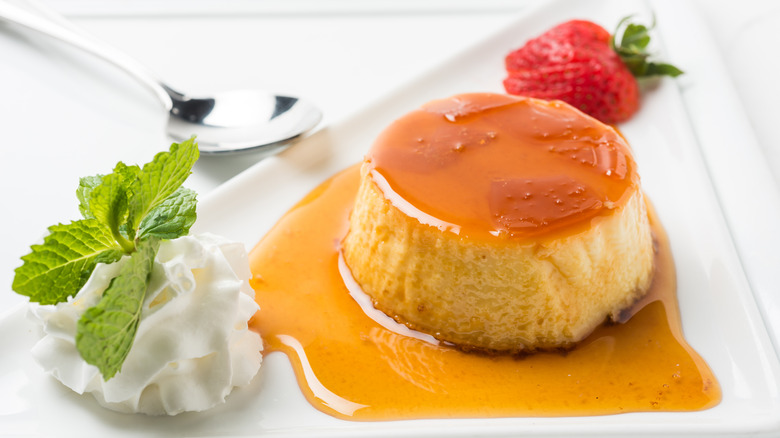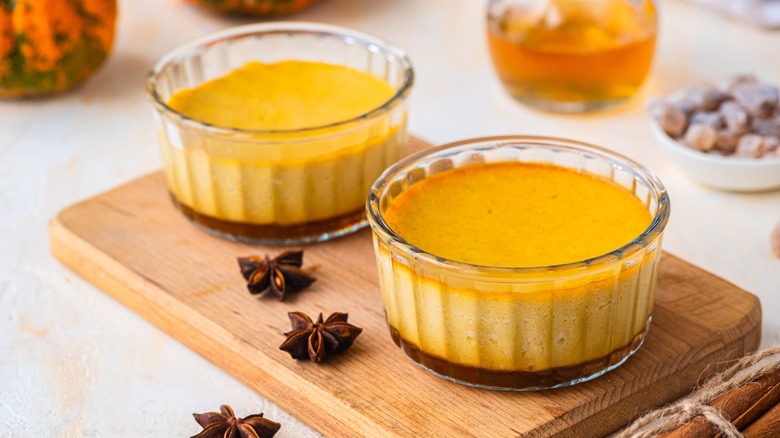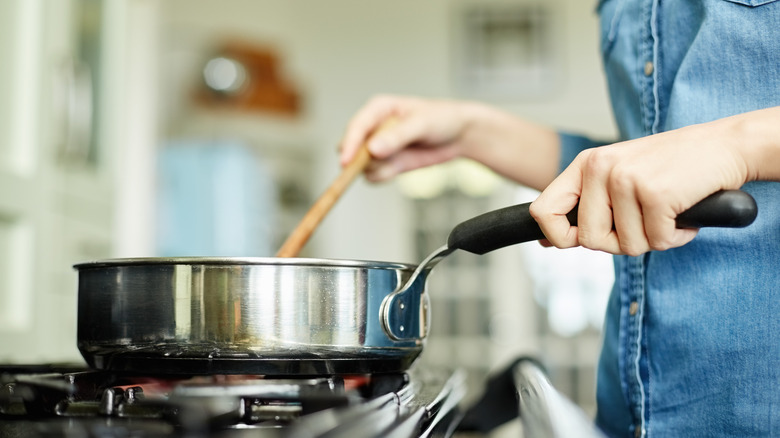The Mess-Free Trick For Removing A Flan From A Ramekin
If you love flan, there's no need to search for a restaurant that serves it. You can make this creamy custard right at home. The traditional flan recipe uses simple ingredients and requires just 20 minutes of prep. The hardest part of the whole procedure might just be getting the flan out of its ramekin. Luckily, we're here to share a mess-free trick for removing flan so you can avoid a sticky situation.
When you're ready for dessert, place your serving plate on top of the ramekin and flip it over as a unit. In an ideal world, the flan will pop out perfectly, but as any seasoned chef knows, this isn't always the case. If your flan refuses to budge, hold the plate and ramekin together tightly, with the plate still on the bottom, and shake. You may be able to feel the flan come loose. You may also hear a slurping sound or see caramel leaking out from the bottom of the ramekin. These are all indications that you have successfully freed your flan.
If you find the flan is stubborn and a reoccurring trend in your kitchen, you might be curious why. You might also be wondering how to avoid the issue altogether. We've dug into this dilemma and discovered potential causes and solutions. So, if you'd like to flip your flan and witness a perfect ramekin release, keep reading. We have just the details you're looking for and handy tips for cooking a fantastic flan.
Why does flan stick to its ramekin to begin with?
Flan usually sticks to its ramekin because the caramel is too thick. This often happens because your caramelized mixture is overcooked or you didn't bake your flan long enough. To understand the issue, let's back up and see how sugar is caramelized and how it melts during the cooking process.
When you heat the sugar and water together, it'll caramelize, and after you pour the caramel into each ramekin, it'll naturally harden. But once you bake the entire flan, this caramel should soften into a sweet, sticky syrup. However, if your caramelized mixture is overcooked, it'll be extra thick and sticky, making it harder to melt. This results in a caramel that clings to the bottom of the ramekin rather than gently releases. But if you cook your sugar to the perfect consistency and it still sticks to the ramekin, then there are a few tips to keep in mind when making your flan.
How to prevent flan from sticking to its ramekin
Making a beautiful flan begins long before you flip that ramekin. There are things to consider throughout the cooking process to prevent flan from sticking. For starters, you'll want to ensure your caramel is the right consistency. As mentioned, an overly thick caramel will have trouble melting, so try mixing a little extra water or even a dollop of butter into your sugar as it cooks. And, of course, take the caramel off the stove once the sugar has completely dissolved and becomes a rich golden brown. Another workaround for sticky flan is to line the ramekins with less caramel. Sometimes, less is more, and a thin layer of caramel will inevitably melt faster.
Before presenting your flan, it should also be adequately cooled and refrigerated. This will ensure the custard keeps its firm shape outside the ramekin. To assist an even smoother release, you can let the ramekin stand in a warm water bath just before serving. Doing this for up to a minute loosens the flan and caramel without sacrificing its shape. Lastly, running a thin knife around the outer edges of the ramekin should help prevent any custard from clinging to the sides.
All these preventative measures will significantly decrease your chances of a flan fiasco. After all, presentation matters, especially when it comes to flan. Once on its serving plate, it should look like a firm but creamy custard swimming in a sea of sweet caramel.


